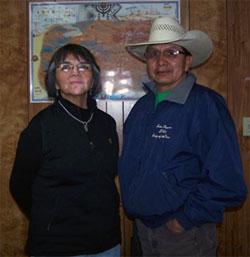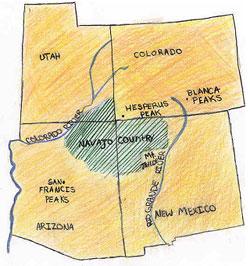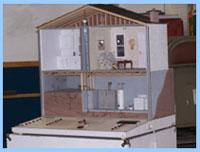The Navajo Nation Radon Program
Tribal Champion
On this page:
As one of only two employees at the Navajo Nation Radon Program, Vivian Craig works hard to ensure healthy and safe learning environments and homes for children and elders in her community. As an educator and liaison in her community, Vivian appreciates the opportunity to work alongside a grassroots movement to improve the lives of the Navajo people.
After becoming an environmental specialist with the radon program in 2000, Vivian immediately became involved in uranium mine waste issues and IAQ outreach through interactive education.
"When you walk into a classroom, the last thing you want to see is a sick child (who) cannot concentrate on learning because he or she doesn't feel well. I work with the Navajo Nation Radon Program because I want to make sure that every child is as safe, healthy and comfortable as possible. There is nothing better than a happy, alert child who is ready and eager to learn." —Vivian Craig
Program Summary
The Navajo Nation Environmental Protection Agency Radon Program has two main priorities:
- Serving as a liaison for a five-year Contaminated Structures Project addressing uranium contamination on the reservation.
- Providing education to the tribal community about the importance of testing for radon in schools and office buildings as well as general indoor air quality (IAQ) outreach.
The Navajo Nation lands are situated on rich radioactive ores containing uranium. Widespread uranium mining took place through the 1940's for national defense and energy purposes — generating 520 abandoned uranium mines. The need for the Navajo Nation to act was clear — waste from abandoned uranium mines pose a risk of lung cancer, bone cancer and impaired kidney function to tribal members living in these areas. The five-year Contaminated Structures Project began in October 2007 with collaboration between several agencies, including the U.S. Environmental Protection Agency, Bureau of Indian Affairs, Indian Health Service, Nuclear Regulatory Commission and U.S. Department of Energy, to address the uranium contamination at abandoned mines, tribal homes and water sources on the reservation.
Outreach and education on radon and other IAQ issues is a huge priority for the Navajo Nation Radon Program. Their role is to serve as a resource and provide technical support to the tribal community. The Program visits Navajo immergence schools and teaches students and teachers about IAQ issues, such as radon, mold and various asthma triggers.
For more information about the NNEPA Radon Program in Window Rock, AZ call (928) 871-7863.
Key Strategies
- Bring All Stakeholders to the Table
- Tailor to Your Community
- Empower Others to Lead
- Build on Success
Bring All Stakeholders to the Table
Vivian Craig and her colleague, John Plummer, realize that there is much more to be done with the NNEPA Radon Program than they can accomplish on their own. By having a realistic approach, the radon program is able to focus on their role as a liaison making sure that the right organizations are working together.
As part of the Contaminated Structures Project Team, the Navajo Nation Radon Program serves as a link between EPA, the engineers, geographers, land use and grazing communities, and the tribal community members involved in assessing and removing Navajo homes built from uranium-contaminated materials. During home visits, the NNEPA Radon Program assists by meeting with occupants, describing the mission of the program and serving as a Navajo interpreter when required.
Tailor to Your Community
The translation of technical terminology into the Navajo language can be a challenge when describing the significance of IAQ management — the health risks associated with asthma triggers or the mitigation needs for schools and homes with high radon levels. To ensure words are being conveyed and interpreted correctly, Vivian carries a conversational Navajo dictionary on her school and home site visits. The radon program also heavily relies on the Navajo Nation science and academic community, including Northern Arizona University, Medicine Men's Association and Rough Rock Demonstration Schools, for assistance on translating technical terms. Acutely aware of the importance of culture in the Navajo Nation community, Vivian and her colleague are cautious about being culturally sensitive when communicating the health risks associated with indoor air quality. Their ability to translate technical terms and keep cultural sensitivity in mind has allowed the program to better communicate with residents who are in high risk areas for elevated radon levels.
The radon program also tailors numerous EPA resources for school visits, including radon activity books and the Learning about Radon, a Part of Nature storybook, which Vivian has turned into a PowerPoint presentation for students. To engage Navajo students on the importance of IAQ issues, the program utilizes an IAQ display house, which offers an interactive way to share this information. The IAQ house — equipped with a quiz — tests the students on the different indoor contaminants found within homes. Tailoring IAQ messages to the Navajo students in their native language has allowed for hands-on activities with students to be more interactive and effective.
Empower Others to Lead
Throughout the years, the radon program has worked on outreach and education efforts in Head Start schools throughout the Navajo Nation. By using resources from the IAQ Tools for Schools Program, the radon program conducts IAQ walkthroughs of their school facilities and buildings while educating students, teachers and facilities and maintenance staff about asthma triggers, such as mold and moisture and the option of utilizing green cleaning products. As a result of this continued effort, Navajo Nation schools are now taking charge. With the education and outreach they have received from the radon program, they understand the importance and need of improving IAQ to enhance the health and safety of students and staff. Two Navajo Nation school districts have made significant strides by ordering their own radon testing canisters and testing their school buildings. These schools help boost the goal of the radon program — to make all schools and school districts self-sufficient in IAQ management in the future. By training facilities and maintenance staff at Navajo schools to recognize IAQ issues on their own, the radon program is able to serve as a resource and provide technical support as needed.
Build on Your Success:
Winning the 2010 Environmental Justice Award from EPA was proof that this program has worked hard to achieve success. Since the beginning of the Contaminated Structures Project in 2007, the Navajo Nation team has screened nearly 200 structures for potential contamination and completed demolition and excavation of 27 contaminated structures and 10 residential yards. They also completed the construction of 14 new homes. The Navajo Nation continues to look forward and set their goals high. Their goal is to have all 522 high-risk mines screened by the end of 2011.
In addition to their devotion to the Contaminated Structures Project, the radon program continues to see success in their efforts to educate and provide outreach on radon and indoor air quality issues. Because of their resources and technical support, school districts in Navajo Nation are becoming self-sufficient in testing for and handing IAQ issues. To build on this success, the NNEPA Radon Program continues to promote radon education to children and teachers through their visits to immersion schools throughout Navajo Nation. Read about their outreach activities for National Radon Action Month featured on Radon Leaders Saving Lives.
Program Profile
Inception of Radon Program: 1990
Population: 289,000
Service Area: Extends into the states of Utah, Arizona and New Mexico, covering 27,000 square miles - larger than the size of West Virginia.
Goals: To help ensure all homes and tribal offices are tested for radon at least once and all schools and day care centers to be tested yearly; And to screen all 520 high-risk mines in Navajo Nation by the end of 2011.
Results: Challenges and Successes
Challenge: Cultural Sensitivity
Success: Approach all tribal members with respect when educating them on IAQ issues, such as radon. Their ability to keep cultural sensitivity in mind has allowed the program to better communicate with residents who are in high risk areas for elevated radon levels.
Challenge: Distance
Success: With limited funding for travel, it is important to be resourceful by trying to piggyback rides out to schools for education/outreach on the same day as the school IAQ walkthroughs.
Challenge: Technical IAQ TermsSuccess: Vivian carries a conversational Navajo dictionary to help her when describing indoor air quality issues to the Navajo people. It also has been helpful to work with immergence schools and Northern Arizona University students to help with translating.



